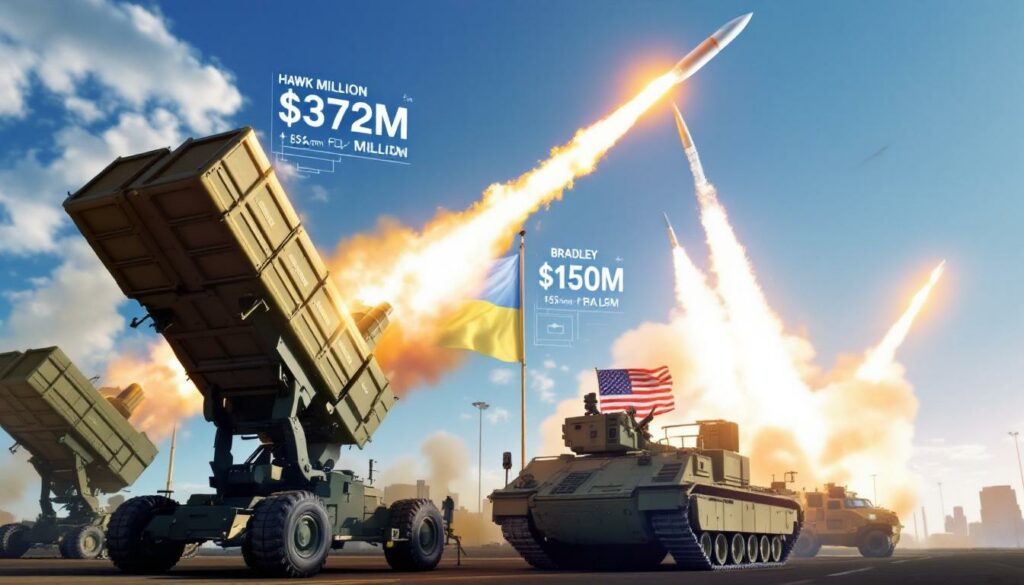What is the U.S. Arms Sale to Ukraine and Why Does it Matter?
The United States has approved a significant military aid package worth $322 million to Ukraine, arriving at a pivotal moment in the ongoing conflict with Russia. This development, occurring as peace negotiations show limited progress, represents a strategic commitment to supporting Ukraine's defensive capabilities while addressing critical maintenance requirements for previously supplied equipment.
The aid package, approved on July 23, 2025, comes as Ukrainian forces continue to face intense Russian strikes on civilian infrastructure and military positions. According to Defense Security Cooperation Agency (DSCA) statements, this support aims to "improve Ukraine's capability to meet current and future threats" while addressing "urgent needs to strengthen local sustainment capabilities."
Military analysts note that this aid package differs from previous ones by focusing heavily on sustainability rather than introducing new weapon systems – a recognition that maintaining existing equipment has become as crucial as deploying new capabilities. Additionally, this approach aligns with broader energy security trends that emphasize resource optimization and strategic allocation.
How Much Military Aid is the U.S. Providing to Ukraine?
The $322 million arms sale to Ukraine focuses on two key military capabilities:
$172 million is allocated for HAWK air defense equipment and sustainment, which will significantly enhance Ukraine's ability to protect its airspace and critical infrastructure from Russian aerial attacks.
$150 million is designated specifically for Bradley Infantry Fighting Vehicle equipment and services, addressing urgent maintenance needs to keep previously supplied vehicles operational on the battlefield.
This funding package has received State Department approval and been formally reported to Congress by the DSCA, though final congressional authorization is still pending as of late July 2025. This represents an important but measured investment compared to President Trump's July 14 announcement pledging "billions of dollars" in weapons through NATO channels.
The aid comes after the Pentagon had temporarily paused other weapons shipments to Ukraine to conduct a comprehensive assessment of U.S. military stockpiles, balancing immediate Ukrainian needs against America's own defense requirements.
What Specific Military Equipment is Being Provided?
HAWK Air Defense Systems
The $172 million allocation for HAWK (Homing All the Way Killer) systems addresses one of Ukraine's most critical vulnerabilities – protection against Russian aerial threats. This medium-range surface-to-air missile system represents a significant upgrade for Ukraine's integrated air defense network.
The HAWK system provides:
- Enhanced detection and engagement capabilities against Russian missiles and drones
- Greater range and accuracy than many of Ukraine's existing air defense systems
- Multiple-target engagement capability, crucial during mass drone attacks
- Improved resistance to electronic warfare measures
The timing of this HAWK support is particularly relevant given recent Russian strikes on Odesa that caused fires in residential buildings and critical infrastructure. According to the DSCA, the HAWK components will create "more robust air defense capability" for Ukrainian forces protecting civilian population centers.
Bradley Infantry Fighting Vehicle Support
Rather than providing new vehicles, the $150 million Bradley package focuses on sustainability and battlefield readiness of Ukraine's existing fleet through:
- Critical spare parts and replacement components
- Specialized maintenance equipment and diagnostic tools
- Technical support services from U.S. contractors
- Advanced training for Ukrainian maintenance personnel
- Logistics infrastructure improvements to support field repairs
"This support addresses Ukraine's urgent need to maintain high operational rates for U.S.-provided vehicles," the DSCA stated, acknowledging the intense battlefield conditions that have strained Ukraine's maintenance capabilities. The Bradley IFVs have become crucial force multipliers for Ukrainian mechanized infantry units, combining mobility, protection, and firepower.
Why is This Arms Sale Significant Now?
Timing Amid Stalled Peace Talks
The approval comes at a particularly sensitive moment in the conflict, with negotiations yielding minimal tangible results:
- Recent talks in Turkey produced "no progress on cessation of hostilities," according to Ukrainian delegate Rustem Umerov
- Ukraine has proposed a high-level meeting between President Zelenskyy and President Putin before the end of August
- Russia has limited its ceasefire offers to 24-48 hour pauses specifically for retrieving bodies
- Both sides have agreed to another substantial prisoner exchange involving at least 1,200 POWs from each side
This military aid package signals continued U.S. support for Ukraine's position despite diplomatic deadlock, potentially strengthening Ukraine's negotiating leverage.
U.S. Policy Shift Context
This arms sale occurs against a backdrop of evolving U.S. policy toward the conflict:
- On July 14, 2025, President Trump announced plans to provide "billions of dollars" in weapons to Ukraine through NATO channels
- The administration established a 50-day deadline for Russia to agree to a ceasefire
- Prior to this announcement, the Pentagon had directed a temporary pause on certain weapons shipments to assess U.S. stockpile levels
- The HAWK and Bradley support represents a targeted approach focused on sustainability rather than escalation
The careful balance between supporting Ukraine while avoiding major escalation reflects the complex geopolitical calculations involved in U.S. policy toward the conflict. This approach is particularly noteworthy given ongoing US-China trade tensions that have further complicated the international landscape.
How Does This Impact Ukraine's Defense Capabilities?
Strengthening Air Defense Networks
The HAWK system addresses a critical vulnerability in Ukraine's defensive infrastructure:
- Improves Ukraine's ability to counter Russian missile and drone attacks that have devastated civilian infrastructure
- Complements existing air defense systems like Patriot, NASAMS, and Soviet-era S-300s
- Creates a more layered and robust defensive network with overlapping coverage zones
- Enhances protection of power stations, command centers, and population centers
The July 23 Russian strikes on Odesa, which caused fires in residential buildings, underscore the urgent need for strengthened air defense capabilities. By bolstering these systems, Ukraine can better protect civilian infrastructure while freeing military resources for offensive operations.
Maintaining Combat Vehicle Readiness
The Bradley support package focuses on sustainability rather than expanding Ukraine's vehicle fleet:
- Addresses urgent maintenance needs that have reduced operational readiness rates
- Provides specialized tools and training to repair battle-damaged vehicles more quickly
- Establishes more robust supply chains for critical replacement parts
- Enables Ukrainian forces to maintain mobility and firepower along extensive front lines
- Reduces vehicle downtime during critical operations
Military logistics experts note that this maintenance-focused approach acknowledges the reality that keeping existing equipment operational has become as strategically important as acquiring new systems after years of high-intensity combat.
What is the Current Battlefield Situation?
Recent Military Activities
The arms sale announcement comes amid continued hostilities on multiple fronts:
- Russian forces struck Odesa on July 23, causing fires in residential buildings and infrastructure
- Ukrainian drones conducted strikes in southern Russian areas, including a successful hit on an oil storage depot
- Operations at Sochi airport were suspended for approximately four hours due to drone debris
- One Russian civilian was killed and another injured in drone-related incidents near Sochi
These recent operations highlight the ongoing nature of the conflict despite diplomatic efforts, with both sides continuing to target each other's strategic infrastructure.
Humanitarian Developments
Despite the combat operations, some humanitarian progress has been achieved:
- Agreement reached on prisoner exchanges for more than 1,200 POWs from each side
- Russia has offered to return approximately 3,000 Ukrainian bodies
- Plans established to exchange severely injured individuals along the front lines
- President Zelenskyy confirmed preparations for these exchanges were underway
Ukrainian Regional Governor Oleh Kiper's reports on civilian infrastructure damage in Odesa underscore the human cost of the conflict and the urgent need for both defensive capabilities and diplomatic solutions.
How Are International Relations Being Affected?
U.S.-Russia Tensions
The arms sale further complicates an already strained U.S.-Russia relationship:
- It reinforces U.S. commitment to Ukraine despite Russian objections to Western weapons transfers
- The sale occurs alongside U.S. threats of economic penalties against countries trading with Russia
- It follows President Trump's 50-day ultimatum to Russia to agree to a ceasefire
- The timing amid peace talks could be interpreted as undermining diplomatic efforts
The careful targeting of the aid toward defensive and sustainability purposes, rather than offensive weapons systems, suggests an attempt to balance support for Ukraine with avoiding major escalation that could derail diplomatic efforts entirely. This approach aligns with recent Trump executive order priorities that emphasize strategic resource management.
NATO Involvement
The sale has significant implications for NATO's role in the conflict:
- It follows discussions between President Trump and NATO Secretary General Mark Rutte about alliance-coordinated weapons procurement
- Signals continued Western commitment despite diplomatic frustrations
- Demonstrates coordination between U.S. bilateral aid and multilateral NATO support
- Suggests a more unified approach to military assistance despite internal alliance debates
This dual-track approach—bilateral U.S. aid alongside NATO coordination—represents a significant evolution in Western support for Ukraine as the conflict continues.
What Are the Economic Implications?
Defense Industry Impact
While the transcript doesn't provide specific details about contractors, the arms sale creates significant opportunities for U.S. defense manufacturers:
- Sustains production lines for critical defense systems during a period of high global demand
- Creates manufacturing and support service opportunities across multiple states
- Generates employment in specialized defence sector positions
- Strengthens relationships between U.S. defense contractors and Ukrainian military
The focus on maintenance and sustainment also creates long-term service relationships that extend beyond the initial equipment sales. Furthermore, this approach reinforces the strategic importance of defence critical materials in maintaining military readiness.
Ukrainian Economic Considerations
For Ukraine, the military aid addresses several economic challenges:
- Reduces the financial burden of maintaining existing equipment, freeing resources for other critical needs
- Helps protect economic infrastructure from aerial attacks that have severely damaged the energy grid
- Supports Ukraine's defense industrial capacity through technology transfer and training
- Improves battlefield performance, potentially strengthening Ukraine's negotiating position
The HAWK systems in particular will help protect critical economic infrastructure that has been repeatedly targeted throughout the conflict.
What Challenges Remain in Resolving the Conflict?
Diplomatic Hurdles
Despite incremental progress on humanitarian issues like prisoner exchanges, fundamental obstacles to peace persist:
- No agreement on cessation of hostilities beyond extremely limited humanitarian pauses
- Drastically different perspectives on what constitutes an acceptable ceasefire framework
- Challenges in arranging high-level meetings between Ukrainian and Russian leadership
- Continued military operations undermining trust-building efforts
Ukrainian negotiator Rustem Umerov's assessment that there was "no progress on cessation of hostilities" during the Turkey talks highlights the substantial diplomatic challenges ahead.
Military Realities
The battlefield situation continues to evolve in ways that complicate diplomatic efforts:
- Russian forces maintain offensive operations in key regions despite high casualties
- Ukrainian defensive capabilities are being enhanced but face persistent resource constraints
- Civilian infrastructure remains highly vulnerable to aerial attacks despite improved air defenses
- Frontline positions continue to shift with tactical gains and losses on both sides
Russian negotiator Vladimir Medinsky's limited proposal for 24-48 hour ceasefires strictly for "body retrieval" indicates minimal Russian interest in comprehensive de-escalation at this stage.
What Does This Mean for Future U.S. Policy?
Short-Term Outlook
In the immediate future, U.S. policy appears focused on a multi-faceted approach:
- Balancing targeted military support with continued diplomatic pressure
- Maintaining the 50-day deadline for Russian engagement in substantive peace talks
- Preserving alliance cohesion on Ukraine support despite internal debates
- Carefully managing weapons transfers to balance Ukrainian needs against U.S. stockpile requirements
This arms package represents a calculated approach that supports Ukraine's defensive capabilities without dramatically escalating the conflict through more provocative systems. However, the potential Trump tariff impact on global trade may further complicate the geopolitical landscape.
Long-Term Considerations
Looking ahead, several factors will shape U.S. policy toward the conflict:
- The outcome of peace negotiations and ceasefire proposals within the 50-day timeframe
- Effectiveness of military aid in strengthening Ukraine's strategic position
- Evolving domestic political considerations in the United States
- Broader geopolitical dynamics including relations with European allies and Asian partners
The HAWK and Bradley support packages, focused on sustainability rather than new capabilities, suggest a long-term commitment to Ukraine's security needs while leaving diplomatic doors open.
FAQ About the U.S. Arms Sale to Ukraine
Is this the largest arms sale to Ukraine since the conflict began?
While significant at $322 million, this is not the largest U.S. arms package to Ukraine. Previous assistance packages have exceeded billions of dollars in value, particularly those including advanced systems like Patriot missile batteries. This package is notable more for its focus on sustainability than its overall size.
Does this arms sale include offensive weapons?
The package focuses primarily on defensive capabilities (air defense) and sustainment for existing vehicles rather than new offensive systems. The HAWK system is designed to protect against aerial threats, while the Bradley component supports maintenance of previously supplied vehicles.
How quickly will this equipment reach Ukrainian forces?
While the specific delivery timeline isn't detailed in official statements, defense logistics typically require months rather than weeks for complex systems. The DSCA notification to Congress marks the beginning of the approval process, with actual delivery contingent on production schedules, training requirements, and transportation arrangements.
Will this military aid affect peace negotiations?
The impact on negotiations is complex. While it strengthens Ukraine's defensive position and potentially its negotiating leverage, it could also be viewed by Russia as escalatory, potentially hardening positions. The careful focus on defensive and sustainment capabilities rather than new offensive systems may mitigate some of these concerns.
What has been Russia's response to the arms sale announcement?
While specific responses to this particular package weren't detailed in available information, Russia has consistently opposed Western arms transfers to Ukraine, viewing them as prolonging the conflict and directly involving NATO countries. Previous similar announcements have prompted diplomatic protests and, in some cases, targeted strikes against weapons depots in Ukraine.
Want to Spot the Next Major Mineral Discovery Before Everyone Else?
Discovery Alert's proprietary Discovery IQ model delivers instant notifications when significant ASX mineral discoveries are announced, giving you a crucial market advantage. Explore our dedicated discoveries page to see how historic mineral findings have generated exceptional returns for early investors.




